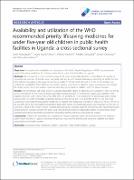| dc.contributor.author | Nsabagasani, Xavier | |
| dc.contributor.author | Ogwal-Okeng, Jasper | |
| dc.contributor.author | Mbonye, Anthony. | |
| dc.contributor.author | Ssengooba, Freddie. | |
| dc.contributor.author | Muhumuza, Simon | |
| dc.contributor.author | Hansen, Ebba Holme. | |
| dc.date.accessioned | 2019-10-31T13:17:00Z | |
| dc.date.available | 2019-10-31T13:17:00Z | |
| dc.date.issued | 2015 | |
| dc.identifier.citation | Nsabagasani, X., Ogwal-Okeng, J., Mbonye, A., Ssengooba, F., Muhumuza, S., & Hansen, E. H. (2015). Availability and utilization of the WHO recommended priority lifesaving medicines for under five-year old children in public health facilities in Uganda: a cross-sectional survey. Journal of Pharmaceutical Policy and Practice, 8(1), 18. | en_US |
| dc.identifier.uri | https://hdl.handle.net/123456789/85 | |
| dc.description.abstract | Objectives: To explore the availability and utilization of the World Health Organization (WHO) recommended
priority life-saving medicines for children under five in public health facilities in Uganda.
Methods: We conducted a cross sectional survey in 32 lower level public facilities in Jinja district of Uganda. A
proportionate number of facilities were randomly selected in each stratum following a hierarchy of Health Centers
(HC) defined according to the level of care they provide: 17 HC IIs, 10 HC IIIs and 5 HC IVs. In the facilities, we
verified the availability of the WHO recommended priority medicines for diarrhea, sepsis, pneumonia and malaria.
81 health workers from the facilities reported what they prescribed for children with the above diseases.
Results: Oral rehydration salt (ORS) and zinc sulphate dispersible tablets for diarrhea were available in all HC IIs and IIIs
and in only 60% of HC IVs. Procaine benzyl penicillin injection powder for treatment of sepsis was available in the
majority of all HCs with: 100% of HC of IVs, 83% of HC IIIs and 82% of HC IIs. Medicines for pneumonia were limited
across all the HCs with: Amoxicillin dispersible tablets in only 30% of the HC IIs and 40% of the HC IVs. The most
uncommon were child-friendly priority medicines for malaria with: Artesunate injection in only 6% of HC IIs, 14% of HC
IIIs and 20% of HC IVs; Artemether lumefantrine dispersible tablets and rectal artesunate were missing in all the 32 HCs.
Less than a third of the health workers reported prescribing zinc sulphate and ORS for diarrhea, 86% reported procaine
benzyl penicillin injection powder for sepsis, and 57% reported amoxicillin dispersible tablets for pneumonia. None
reported prescribing Artemether lumefantrine dispersible tablets and rectal artesunate for malaria.
Conclusions: There is low availability and utilization of life-saving priority medicines for pneumonia and malaria in
public health facilities in Uganda. However, the priority medicines for diarrhea and sepsis are available and highly
prescribed by the health workers. | en_US |
| dc.language.iso | en | en_US |
| dc.publisher | Journal of Pharmaceutical Policy and Practice | en_US |
| dc.subject | Lifesaving priority medicines | en_US |
| dc.subject | Children under five | en_US |
| dc.subject | Public health facilities | en_US |
| dc.subject | Uganda | en_US |
| dc.title | Availability and utilization of the WHO recommended priority lifesaving medicines for under five-year old children in public health facilities in Uganda: a cross-sectional survey | en_US |
| dc.type | Article | en_US |

